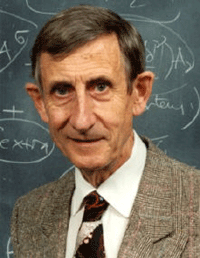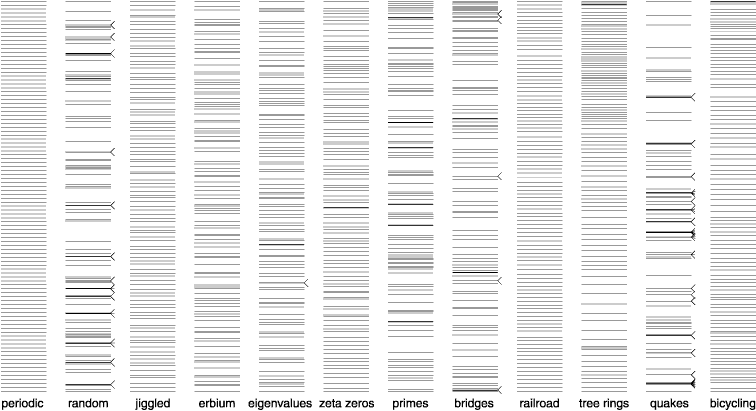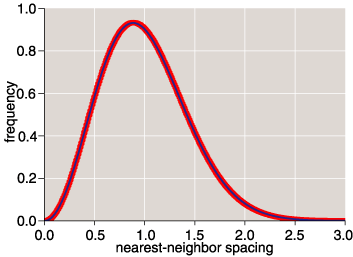
 Montgomery Pic Mia, Odlyzko Pic
Mia
Montgomery Pic Mia, Odlyzko Pic
MiaThe year: 1972. The scene: Afternoon tea in Fuld Hall at the Institute for Advanced Study. The camera pans around the Common Room, passing by several Princetonians in tweeds and corduroys, then zooms in on Hugh Montgomery, boyish Midwestern number theorist with sideburns. He has just been introduced to Freeman Dyson, dapper British physicist.
Dyson: So tell me, Montgomery, what have you been up to? 
Dyson: Extraordinary! Do you realize that's the pair-correlation function for the eigenvalues of a random Hermitian matrix? It's also a model of the energy levels in a heavy nucleus—say U-238.
"I'd
never heard any of these terms before," Montgomery went on. "I don't
know exactly what
his words were because I have heard all of these terms many times
since, but he said 'pair
correlation' and something resembling 'random matrices'..."
What
Dyson meant:
The
pair correlations of the Riemann zeros and the eigenvalues are not
random but seem to obey the same statistics.


Zeros of the Riemann zeta function
have nearest-neighbor spacings
closely matched by the predictions of random-matrix theory. Red dots
represent positions of a billion zeta zeros above the 1023rd
such zero; the blue line is the predicted spacing.
Note: it sort of resembles
that of the "Central Limit Theorem". Actually the Gaussian Unitary
Ensemble GUE or the Gaudin Distribution.
Over the past 20 years Andrew M.
Odlyzko, now at the University of Minnesota, has taken the computation
of zeta zeros to heroic heights in order to perform such tests. One of
Odlyzko's early papers was titled "The 1020th zero of the
Riemann zeta function and 175 million of its neighbors." Since then he
has gone on to compute even longer series of consecutive zeros at even
greater heights, now reaching the neighborhood of the 1023rd
zero.
The correspondence is now
known as the Dyson-Odlyzko-Montgomery Law
Note: The basic idea of finding an infinite dimensional matrix
whose eigenvalues could correspond to the zeros of the Riemann Zeta
function is actually attributed to Polya and Hilbert who in 1914 first
posited this possibility. This view is that the zeros of the zeta
function really do represent a spectrum—a series of energy levels just
like those of the erbium nucleus, but generated by the mathematical
element Riemannium.